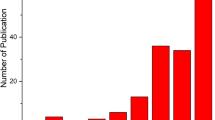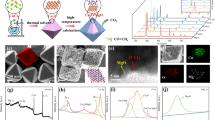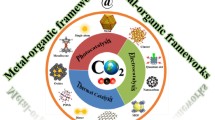Abstract
Carbon dioxide (CO2), as one of the main greenhouse gases, has been focused on for photoreduction into useful chemical fuels under solar light irradiation to solve the problems of global warming and energy shortage. The key factor is the catalyst and the core–shell structured nanomaterial is regarded as a promising photocatalyst, with the advantages of large specific surface areas, novel electronic structures, and strong synergistic interfacial interactions. Herein, the chapter highlights recent advances in developing core–shell structured photocatalysts for the reduction in CO2. The systems of various zero dimensional (0D) nanoparticles, 1D nanofibers/nanotubes, 2D nanosheets, and 3D hierarchical nanocomposites have mainly been described, including noble metals, carbon nanofibers/nanotubes, 1D metal oxides, 2D graphene, g-C3N4, 3D MOFs, etc. It has been proposed that the design and synthesis of nanocomposites with core–shell structures are beneficial for the fast charge separation/migration, rich light absorption, and efficient reactant CO2 adsorption/activation under the influences of Z-scheme, polarization, and built-in electric field, thus promoting the photocatalytic performance and active intermediate formation. Furthermore, the synergistic interaction mechanisms of multistep electrons transfer and CO2 adsorption-photoreduction are addressed, especially the importance of reactive sites on photocatalysts, such as vacancies in the crystal lattice, anchoring functional groups, doping single heterogeneous atoms, and fabricating Lewis acid/base pairs. Based on the current state-of-the-art for CO2 photocatalytic conversion far from the practical realization, a perspective on the direction and prospect of the controllable core–shell structured nanocomposites for photocatalytic CO2 reduction in future is concluded.
Access this chapter
Tax calculation will be finalised at checkout
Purchases are for personal use only
Similar content being viewed by others
References
Watson CS, White NJ, Church JA, King MA, Burgette RJ, Legresy B (2015) Unabated global mean sea-level rise over the satellite altimeter era. Nat Clim Change 5:565–568
Liu X, Iocozzia J, Wang Y, Cui X, Chen Y, Zhao S, Li Z, Lin Z (2017) Noble metal–metal oxide nanohybrids with tailored nanostructures for efficient solar energy conversion, photocatalysis and environmental remediation. Energy Environ Sci 10:402–434
Kim W, Edri E, Frei H (2016) Hierarchical inorganic assemblies for artificial photosynthesis. Acc Chem Res 49:1634–1645
Inoue T, Fujishima A, Konishi S, Honda K (1979) Photoelectrocatalytic reduction of carbon dioxide in aqueous suspensions of semiconductor powders. Nature 277:637–638
Tu W, Zhou Y, Zou Z (2014) Photocatalytic conversion of CO2 into renewable hydrocarbon fuels: state-of-the-art accomplishment, challenges, and prospects. Adv Mater 26:4607–4626
Marszewski M, Cao S, Yu J, Jaroniec M (2015) Semiconductor-based photocatalytic CO2 conversion. Mater Horiz 2:261–278
Li K, Peng B, Peng T (2016) Recent advances in heterogeneous photocatalytic CO2 conversion to solar fuels. ACS Catal 6:7485–7527
Zhao G, Huang X, Wang X, Wang X (2017) Progress in catalyst exploration for heterogeneous CO2 reduction and utilization: a critical review. J Mater Chem A 5:21625–21649
Zhang Q, Lee I, Joo JB, Zaera F, Yin Y (2013) Core-shell nanostructured catalysts. Acc Chem Res 46:1816–1824
Bell A (2003) The impact of nanoscience on heterogeneous catalysis. Science 299:1688–1691
Zou W, Xu L, Pu Y, Cai H, Wei X, Luo Y, Li L, Gao B, Wan H, Dong L (2019) Advantageous interfacial effects of AgPd/g-C3N4 for photocatalytic hydrogen evolution: electronic structure and H2O dissociation. Chem Eur J 25:1–8
Xiong Y, Wiley BJ, Xia Y (2007) Nanocrystals with unconventional shapes—a class of promising catalysts. Angew Chem Int Ed 46:7157–7159
Zou W, Deng B, Hu X, Zhou Y, Pu Y, Yu S, Ma K, Sun J, Wan H, Dong L (2018) Crystal-plane-dependent metal oxide-support interaction in CeO2/g-C3N4 for photocatalytic hydrogen evolution. Appl Catal B-Environ 238:111–118
Zhu C, Wang Y, Jiang Z, Xu F, Xian Q, Sun C, Tong Q, Zou W, Duan X, Wang S (2019) CeO2 nanocrystal-modified layered MoS2/g-C3N4 as 0D/2D ternary composite for visible-light photocatalytic hydrogen evolution: Interfacial consecutive multi-step electron transfer and enhanced H2O reactant adsorption. Appl Catal B-Environ 259:118072–118081
Shao Q, Wang P, Liu S, Huang X (2019) Advanced engineering of core/shell nanostructures for electrochemical carbon dioxide reduction. J Mater Chem A 7:20478–20493
Li W, Elzatahry A, Aldhayan D, Zhao D (2018) Core-shell structured titanium dioxide nanomaterials for solar energy utilization. Chem Soc Rev 47:8203–8237
Zhang X, Peng T, Song S (2016) Recent advances in dye-sensitized semiconductor systems for photocatalytic hydrogen production. J Mater Chem A 4:2365–2402
Yuan Y, Ruan L, Barber J, Joachim Loo SC, Xue C (2014) Hetero-nanostructured suspended photocatalysts for solar-to-fuel conversion. Energy Environ Sci 7:3934–3951
Guo Y, Shi W, Zhu Y (2019) Internal electric field engineering for steering photogenerated charge separation and enhancing photoactivity. EcoMat 23:1–20
Zhu C, Wang Y, Jiang Z, Liu A, Pu Y, Xian Q, Zou W, Sun C (2019) Ultrafine Bi3TaO7 nanodot-decorated V, N codoped TiO2 nanoblocks for visible-light photocatalytic activity: interfacial effect and mechanism insight. ACS Appl Mater Interfaces 11:13011–13021
Lee J, Sorescu DC, Deng X (2011) Electron-induced dissociation of CO2 on TiO2(110). J Am Chem Soc 133:10066–10069
Zhang Y, Xia B, Ran J, Davey K, Qiao SZ (2020) Atomic-level reactive sites for semiconductor-based photocatalytic CO2 reduction. Adv Energy Mater 10:1903879–1903901
Wei Y, Jiao J, Zhao Z, Liu J, Li J, Jiang G, Wang Y, Duan A (2015) Fabrication of inverse opal TiO2-supported Au@CdS core–shell nanoparticles for efficient photocatalytic CO2 conversion. Appl Catal B-Environ 179:422–432
Pougin A, Dodekatos G, Dilla M, Tuysuz H, Strunk J (2018) Au@TiO2 core-shell composites for the photocatalytic reduction of CO2. Chem Eur J 24:12416–12425
Zhai Q, Xie S, Fan W, Zhang Q, Wang Y, Deng W, Wang Y (2013) Photocatalytic conversion of carbon dioxide with water into methane: platinum and copper(I) oxide co-catalysts with a core-shell structure. Angew Chem Int Ed 52:5776–5779
Kumar D, Park CH, Kim CS (2018) Robust multimetallic plasmonic core-satellite nanodendrites: highly effective visible-light-induced colloidal CO2 photoconversion system. ACS Sustain Chem Eng 6:8604–8614
Bera S, Lee JE, Rawal SB, Lee WI (2016) Size-dependent plasmonic effects of Au and Au@SiO2 nanoparticles in photocatalytic CO2 conversion reaction of Pt/TiO2. Appl Catal B-Environ 199:55–63
Kamimura S, Yamashita S, Abe S, Tsubota T, Ohno T (2017) Effect of core@shell (Au@Ag) nanostructure on surface plasmon-induced photocatalytic activity under visible light irradiation. Appl Catal B-Environ 211:11–17
Cai X, Wang F, Wang R, Xi Y, Wang A, Wang J, Teng B, Bai S (2020) Synergism of surface strain and interfacial polarization on Pd@Au core–shell cocatalysts for highly efficient photocatalytic CO2 reduction over TiO2. J Mater Chem A 8:7350–7359
Yin G, Huang X, Chen T, Zhao W, Bi Q, Xu J, Han Y, Huang F (2018) Hydrogenated blue titania for efficient solar to chemical conversions: preparation, characterization, and reaction mechanism of CO2 reduction. ACS Catal 8:1009–1017
Yuan L, Han C, Pagliaro M, Xu Y (2015) Origin of enhancing the photocatalytic performance of TiO2 for artificial photoreduction of CO2 through a SiO2 coating strategy. J Phys Chem C 120:265–273
Yin G, Bi Q, Zhao W, Xu J, Lin T, Huang F (2017) Efficient conversion of CO2 to methane photocatalyzed by conductive black titania. ChemCatChem 9:4389–4396
Gui M, Chai S, Xu B, Mohamed A (2014) Enhanced visible light responsive MWCNT/TiO2 core–shell nanocomposites as the potential photocatalyst for reduction of CO2 into methane. Sol Energy Mater Sol Cells 122:183–189
Gui MM, Wong WMP, Chai S-P, Mohamed AR (2015) One-pot synthesis of Ag-MWCNT@TiO2 core–shell nanocomposites for photocatalytic reduction of CO2 with water under visible light irradiation. Chem Eng J 278:272–278
Zhang J, Fu J, Chen S, Lv J, Dai K (2018) 1D carbon nanofibers@TiO2 core-shell nanocomposites with enhanced photocatalytic activity toward CO2 reduction. J Alloys Compd 746:168–176
Li M, Zhang L, Fan X, Wu M, Wang M, Cheng R, Zhang L, Yao H, Shi J (2017) Core-shell LaPO4/g-C3N4 nanowires for highly active and selective CO2 reduction. Appl Catal B-Environ 201:629–635
Li Y, Tang Z, Zhang J, Zhang Z (2017) Fabrication of vertical orthorhombic/hexagonal tungsten oxide phase junction with high photocatalytic performance. Appl Catal B-Environ 207:207–217
Wang C, Zhao Y, Xu H, Li Y, Wei Y, Liu J, Zhao Z (2020) Efficient Z-scheme photocatalysts of ultrathin g-C3N4-wrapped Au/TiO2-nanocrystals for enhanced visible-light-driven conversion of CO2 with H2O. Appl Catal B-Environ 263:118314–118326
He F, Zhu B, Cheng B, Yu J, Ho W, Macyk W (2020) 2D/2D/0D TiO2/C3N4/Ti3C2 MXene composite S-scheme photocatalyst with enhanced CO2 reduction activity. Appl Catal B-Environ 272:119006–119017
Guo Q, Wan Y, Hu B, Wang X (2018) Carbon-nitride-based core–shell nanomaterials: synthesis and applications. J Mater Sci-Mater El 29:20280–20301
Kuai L, Zhou Y, Tu W, Li P, Li H, Xu Q, Tang L, Wang X, Xiao M, Zou Z (2015) Rational construction of a CdS/reduced graphene oxide/TiO2 core–shell nanostructure as an all-solid-state Z-scheme system for CO2 photoreduction into solar fuels. RSC Adv 5:88409–88413
Zhao Y, Wei Y, Wu X, Zheng H, Zhao Z, Liu J, Li J (2018) Graphene-wrapped Pt/TiO2 photocatalysts with enhanced photogenerated charges separation and reactant adsorption for high selective photoreduction of CO2 to CH4. Appl Catal B-Environ 226:360–372
Li R, Hu J, Deng M, Wang H, Wang X, Hu Y, Jiang H, Jiang J, Zhang Q, Xie Y, Xiong Y (2014) Integration of an inorganic semiconductor with a metal-organic framework: a platform for enhanced gaseous photocatalytic reactions. Adv Mater 26:4783–4788
Deng X, Yang L, Huang H, Yang Y, Feng S, Zeng M, Li Q, Xu D (2019) Shape-defined hollow structural Co-MOF-74 and metal nanoparticles@Co-MOF-74 composite through a transformation strategy for enhanced photocatalysis performance. Small 15:1902287–1902293
Li D, Yu S, Jiang H (2018) From UV to near-infrared light-responsive metal-organic framework composites: plasmon and upconversion enhanced photocatalysis. Adv Mater 30:1707377–1707383
Pipelzadeh E, Rudolph V, Hanson G, Noble C, Wang L (2017) Photoreduction of CO2 on ZIF-8/TiO2 nanocomposites in a gaseous photoreactor under pressure swing. Appl Catal B-Environ 218:672–678
Su Y, Xu H, Wang J, Luo X, Xu Z, Wang K, Wang W (2018) Nanorattle Au@PtAg encapsulated in ZIF-8 for enhancing CO2 photoreduction to CO. Nano Res 12:625–630
Tan JZY, Xia F, Maroto-Valer MM (2019) Raspberry-like microspheres of core-shell Cr2O3@TiO2 nanoparticles for CO2 photoreduction. Chemsuschem 12:5246–5252
Wang W, Xu D, Cheng B, Yu J, Jiang C (2017) Hybrid carbon@TiO2 hollow spheres with enhanced photocatalytic CO2 reduction activity. J Mater Chem A 5:5020–5029
Gong Y, Wang DP, Wu R, Gazi S, Soo HS, Sritharan T, Chen Z (2017) New insights into the photocatalytic activity of 3-D core-shell P25@silica nanocomposites: impact of mesoporous coating. Dalton Trans 46:4994–5002
Yang X, Zhang Y, Wang Y, Xin C, Zhang P, Liu D, Mamba BB, Kefeni KK, Kuvarega AT, Gui J (2020) Hollow β-Bi2O3@CeO2 heterostructure microsphere with controllable crystal phase for efficient photocatalysis. Chem Eng J 387:124100–124108
Ijaz S, Ehsan MF, Ashiq MN, Karamat N, He T (2016) Preparation of CdS@CeO2 core/shell composite for photocatalytic reduction of CO2 under visible-light irradiation. Appl Surf Sci 390:550–559
Wang F, Li Q, Xu D (2017) Recent progress in semiconductor-based nanocomposite photocatalysts for solar-to-chemical energy conversion. Adv Energy Mater 7:1700529–1700547
Wei Y, Jiao J, Zhao Z, Zhong W, Li J, Liu J, Jiang G, Duan A (2015) 3D ordered macroporous TiO2-supported Pt@CdS core–shell nanoparticles: design, synthesis and efficient photocatalytic conversion of CO2 with water to methane. J Mater Chem A 3:11074–11085
Li P, He T (2018) Common-cation based Z-scheme ZnS@ZnO core-shell nanostructure for efficient solar-fuel production. Appl Catal B-Environ 238:518–524
Liang Z, Yan C-F, Rtimi S, Bandara J (2019) Piezoelectric materials for catalytic/photocatalytic removal of pollutants: recent advances and outlook. Appl Catal B-Environ 241:256–269
Author information
Authors and Affiliations
Corresponding author
Editor information
Editors and Affiliations
Rights and permissions
Copyright information
© 2021 The Author(s), under exclusive license to Springer Nature Singapore Pte Ltd.
About this chapter
Cite this chapter
Zou, W., Wei, X., Dong, L. (2021). Core–Shell Materials for Photocatalytic CO2 Reduction. In: Yamashita, H., Li, H. (eds) Core-Shell and Yolk-Shell Nanocatalysts. Nanostructure Science and Technology. Springer, Singapore. https://doi.org/10.1007/978-981-16-0463-8_13
Download citation
DOI: https://doi.org/10.1007/978-981-16-0463-8_13
Published:
Publisher Name: Springer, Singapore
Print ISBN: 978-981-16-0462-1
Online ISBN: 978-981-16-0463-8
eBook Packages: Chemistry and Materials ScienceChemistry and Material Science (R0)




